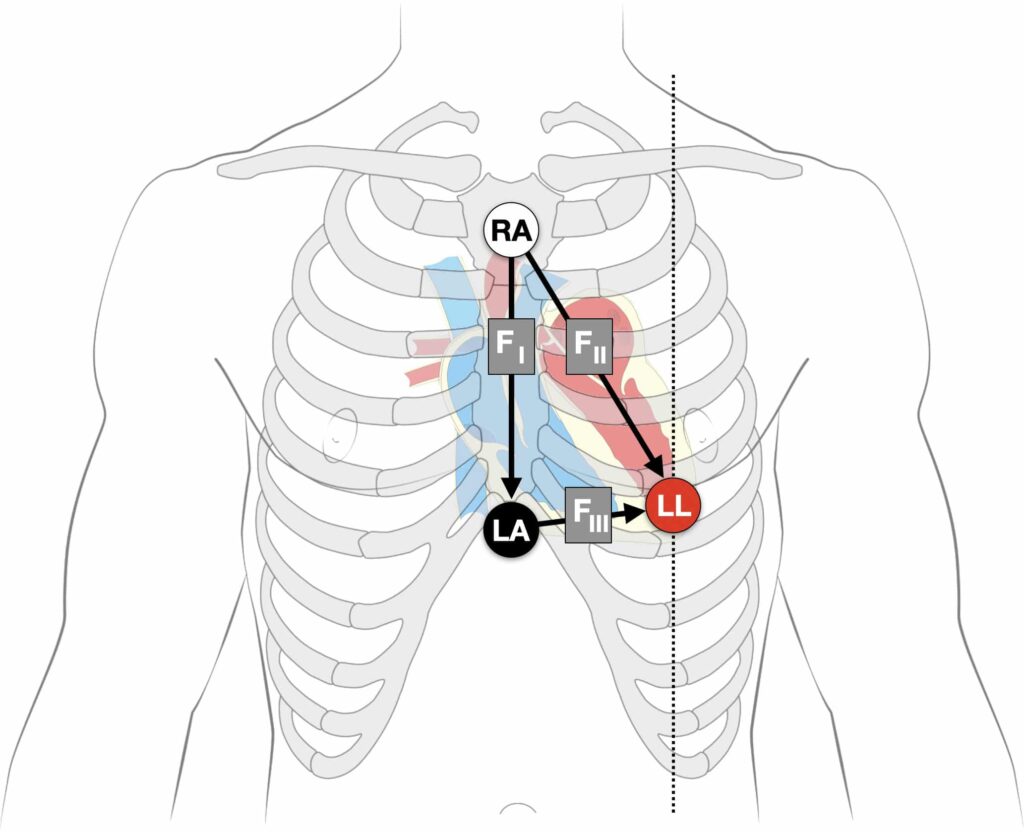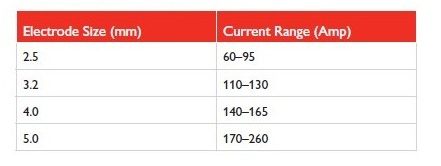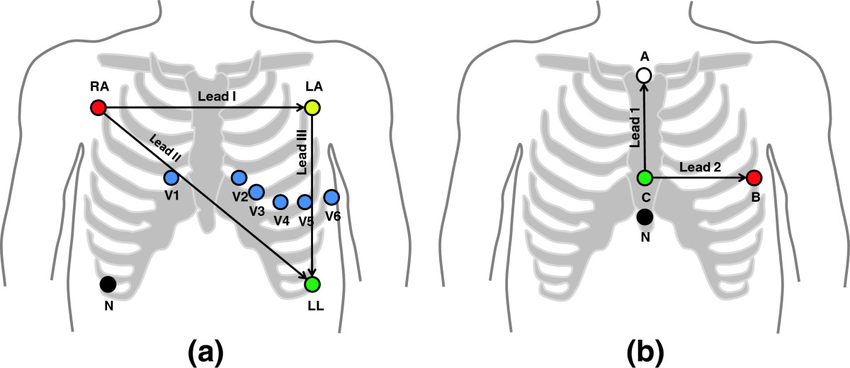The 12-lead ECG is a test used to diagnose many different heart conditions. The test measures electrical activity in the heart and records it on paper. A 12-lead ECG can be performed in several ways, each with its own advantages and disadvantages.
Why Is a 12 Lead ECG Used?
The 12-lead ECG was developed for two main reasons:
To find abnormalities that may not show up on a standard ECG (e.g., atrial fibrillation)
To increase the amount of information available from an ECG recording
The 12-lead ECG is the most common form of electrocardiography. It is used to diagnose many cardiovascular diseases and conditions, including myocardial infarction (heart attack).
The 12-lead ECG was first introduced in 1957 by Wilson Greatbatch. The 12 leads incorporate measuring from six limbs and the chest wall in addition to the standard limb leads.
The use of 12 leads allows for a more detailed picture of electrical activity within the heart. This enables physicians to accurately diagnose cardiac arrhythmia, electrolyte abnormalities and other heart conditions that may not be detectable with a standard ECG.
The 12-lead ECG is used to diagnose and treat patients with arrhythmias.
A 12-lead ECG can be used to diagnose and treat a wide variety of cardiac problems, including heart attacks, abnormal heart rhythms, heart failure and cardiomyopathy.
The 12-lead ECG has several benefits over the standard 6-lead ECG:
It provides a more complete picture of what’s going on in the heart.
It can help differentiate between different types of arrhythmias.
It helps identify areas where there may be blockages in the arteries (ischemia).
What is a 3 lead ECG used for?
A 3 lead ECG is a recording of the electrical activity of your heart. The way it works is that the ECG machine picks up the tiny electrical signals produced by your heart and records them on paper. The three main leads are called aVR, aVL and aVF.
The leads are attached to your skin with sticky patches and each lead picks up signals from different areas of the heart.
aVR – This lead is attached to the right arm or shoulder and picks up signals from the right ventricle (RV) of the heart. It’s sometimes called Lead I.
aVL – This lead is attached to the left arm or shoulder and picks up signals from the left ventricle (LV) of the heart. It’s sometimes called Lead II.
aVF – This lead is attached to your lower back at around waist height and picks up signals from both atria (top chambers), as well as some parts of both ventricles (bottom chambers). It’s sometimes called Lead III
A 3 lead ECG is a test that records the electrical impulses of your heart. It shows how well your heart is pumping blood and how quickly your heart beats.
The test checks for:
Heart rhythm problems, like arrhythmia (abnormal heartbeat).
Heart muscle damage, such as myocardial infarction (heart attack).
Heart valve problems, such as mitral valve prolapse.
Heart defects present at birth, such as ventricular septal defect (VSD) or atrial septal defect (ASD).
Where do the leads go on a 3 lead ECG?

The three leads on a standard ECG are:
Lead I – The lead in the tightest relationship to the heart. It is usually the lead that shows a clear P-wave or PQRS complex. Lead I is also called the “left arm” lead, since it is measured from the left arm (or right leg) electrodes.
Lead II – This lead has one electrode on each shoulder and one over the left hip (in a vertical line down through the sternum). The heart’s electrical activity is measured as it passes through this vertical plane between these electrodes. It can be used to detect atrial arrhythmias and some ventricular arrhythmias, but not always accurately.
Lead III – This lead is placed (usually on the right leg) at a point halfway between leads I and II along an imaginary line connecting them (between where the heart would be if your arms were outstretched to your sides). It detects electrical activity traveling into the ventricles from above (and often shows ST segment deviations).
The leads of an ECG are placed on the body to record the electrical activity of the heart. The ECG is a graph of this activity, and the leads are connected to different parts of the body in order to obtain the best possible recording.
Leads I and II are attached to the limbs, while lead III is attached between the chest wall and one limb (usually left arm). Lead V1 is attached between two limbs (usually left arm and left leg).
What is 3 lead ECG monitoring?
3 lead ECG monitoring is a device that allows you to monitor your heart rate and rhythm. The device uses small pads to attach to your chest, arms and legs. It measures electrical impulses that move through the heart muscle. It records them as an electrical signal known as an electrocardiogram (ECG). This can help detect certain heart problems, such as irregular heartbeats or rhythm disturbances.
How does 3 lead ECG monitoring work?
When you have 3 lead ECG monitoring, a technician puts small sticky pads on your chest, arms and legs. These pads connect to wires that are connected to a machine called a monitor. The monitor records the electrical signals from your heart, which are known as an electrocardiogram (ECG). The ECG shows up on the screen of the monitor as waves moving across it, like waves in water.
The technician positions each pad carefully so it can record the electrical activity from different parts of your heart at once. Each pad has two electrodes attached to it: one positive and one negative electrode (a plus sign and a minus sign). When you lay down on your back with the pads against your skin, these electrodes will connect with enough skin surface area for them to work properly.
The three lead ECG monitor is a portable device that records the electrical activity of the heart. This device can be used at home or in the doctor’s office to monitor your heart rhythm.
The three lead ECG monitor consists of three electrodes (wires) that are attached to your chest, arms and ankles. These wires send electrical signals from your heart to an amplifier. The amplified signals are then transmitted to a recorder that displays your heart rhythm as waves on a strip of paper called an electrocardiogram (ECG).
The three lead ECG monitor is often used to detect problems with the heart rhythm, such as arrhythmias (abnormal heart rhythms) or conduction blocks (when the electrical impulse can’t get through). The three lead ECG monitor may also be used when you’re having symptoms like chest pain or shortness of breath.
Why do we use three electrodes?
There are many reasons why we use three electrodes.
One of the main reasons is to measure the shape of your head. We want to know where your hairline is, where your forehead is, and where your nose begins. You can see this in our User Guide:
There are many ways that we can measure your head shape, such as using a laser or a camera. However, these methods have limitations, especially if you have long hair or wear hats frequently. Our electrodes allow us to measure these features of your head without any additional hardware (other than our device).
Another reason we use three electrodes is because they allow us to determine which direction the hair moves when you move your head around (for example when talking). This allows us to get more accurate measurements.
The reason we use three electrodes, rather than two or four, is to keep the area around the electrode (the “skin”) at a constant potential. This is important because the skin is sensitive to electrical stimulation. If we used only two electrodes, one on each side of the head, we would have to apply negative voltage to one electrode and positive voltage to the other. This would cause current flow through the skin, which could be painful or uncomfortable.
By using three electrodes, we can arrange them in such a way as to create a triangle where all points are at 0 V (ground), with the positive terminal connected to one side of an electrode and the negative terminal connected to another side of that same electrode. This keeps current from flowing through your body by keeping all points at 0 V (ground).
What are 4 types of electrodes?

Electrodes are electrical conductors that produce an electric current when subjected to a voltage difference. They can either be used with batteries or power supplies. Electrodes are used in many applications, including electroplating, electroforming and electrochemical machining.
Types of Electrodes
There are 4 types of electrodes:
Cathode: An electrode that has an oxidation reaction when it is subjected to an electrical current.
Anode: An electrode that has a reduction reaction when it is subjected to an electrical current. The anode is usually placed on the negative side of a circuit and serves as the positive terminal for all ionic reactions in electrolysis.
Electrode pair: A cathode/anode combination, usually connected together by wires or other conductors so they can be used in a circuit.
Platinum wire: A very thin wire made of platinum, which is used for high-temperature applications such as soldering irons and induction heating furnaces
There are four types of electrodes:
1. Electrodes for electroplating and electroforming. These are used in the deposition of metals onto a pattern. They may be made from platinum, gold, silver, or other metals. The surface of the electrode is usually coated with graphite to assist in making a good contact with the solution.
2. Electrodes for electrolysis. These are used in an electrolytic cell to provide an electrical current when immersed in an electrolyte solution such as sulfuric acid or sodium hydroxide. The electrode material is usually platinum, gold, silver (as discussed previously), or carbon (graphite).
3. Electrodes for electroforming glass and ceramics on metal patterns are similar to those used for electroplating and electroforming except that they are made from noble metals such as platinum or gold instead of graphite or other conductive materials used in plating and forming electrodes.
4. Electrodes for arc welding may be referred to as welding rods or electrodes but they are actually welding rods because they cannot be used for any other purpose than arc welding.
Different kinds of electrodes are used for different applications. The type of electrode you use is dependent upon the thickness of the material being welded and the amount of heat required.
Electrodes come in a wide range of sizes and shapes. Here are four types of electrodes:
1) E6010 Electrodes
E6010 electrodes are a common type of electrode used in welding mild steel, stainless steel and aluminum. They have an E-type flux coating which makes them easier to weld with than other types of electrodes. E6010 electrodes come in two different sizes: 1/8″ diameter and 5/64″ diameter.
2) E7018 Electrodes
E7018 electrodes are commonly used for welding carbon steel, stainless steel, cast iron and other alloys that require higher temperatures than what E6010 electrodes can provide. E7018 electrodes come in two different sizes: 1/8″ diameter and 5/64″ diameter.
3) E8015 Electrodes
E8015 electrodes are commonly used for welding thinner materials such as sheet metal or when working in close quarters where there isn’t much room for error (for example, when welding on an assembly line). They have a higher tensile strength than other types of
What are the 5 types of electrodes?
There are five types of electrodes:
- Steel Electrodes
- Tungsten Electrodes
- Aluminum Electrodes
- Copper Electrodes
- Nylon-Coated Electrodes
The five types of electrodes used in electrostatic spray painting are:
- Silver Corrosion Resistant Electrodes
- Nickel Plating Electrodes
- Nickel Alloy Plating Electrodes
- Stainless Steel Electrodes
- Copper Plating Electrodes
Electrodes are the part of a circuit which carries the current. The most common electrodes are made of metal, but they can be made from any material that’s able to conduct electricity.
- Solid Electrodes
These electrodes are made of a solid metal, like copper or silver. The current flows through the entire electrode, and the metal itself is used up in the process. Solid electrodes are used in everything from batteries to power plants and even in your car!
- Liquid Electrodes
Liquid electrodes work in exactly the same way as solid electrodes, except they are made from a liquid rather than a solid piece of metal. They can be used for applications where it would be too difficult to use solid electrodes instead (for example when you want to put an electrode into a fluid). Liquid electrodes also tend to be cheaper than solid ones because it’s easier to make them out of cheaper materials like nickel chloride rather than pure silver or gold!
- Gas Electrodes
Gas electrodes are used in situations where it’s difficult or dangerous to use other types of electrodes – for example if you want to use an electrode inside a chemical reaction vessel or under high pressure conditions where gases might build up around your other types of
There are many different types of electrodes, but the most common ones are:
Galvanic – These electrodes use a direct current to produce a chemical reaction that results in a flow of electrons.
Thermionic – These electrodes use heat produced by an electric current to generate electrons.
Chemical – These electrodes use a chemical reaction to produce electricity.
Photoelectric – These electrodes convert light (photons) into electrical energy using semiconductor materials like silicon and germanium.
Why are electrodes different sizes?

The size of an electrode is important because it influences the amount of current that can be delivered. Electrodes come in many sizes, from tiny surface area electrodes (such as those used for EEG) to large surface area electrodes (such as those used in TENS units).
The size of an electrode affects the amount of current delivered by the device. The larger the surface area, the more current can be delivered through it. This means that a small surface area electrode will deliver less current than a larger one.
The size of an electrode also determines how well it is able to conduct electricity. Large electrodes are better at conducting electricity than smaller ones because they have more surface area available for electrons to flow through them.
Electrodes are a critical part of the electrochemical process used to produce hydrogen and oxygen from water. The electrodes must be able to withstand the conditions of electrolysis and provide a good surface for the reaction.
The electrode size determines several things:
The amount of current it can handle before becoming too hot (or in some cases, melting)
How quickly it can transfer electrons from the anode to the cathode (the larger the area, the faster)
How much energy it requires to make a complete circuit
The size of the electrodes used in ECT is determined by the size of the patient’s head. The electrodes are placed on either side of the head, just above and behind each ear.
Electrodes must be placed so that they are not touching bone or skin, because these areas do not conduct electricity well.
The size of an electrode also depends on how much current will be used during ECT. The amount of voltage is related to the amount of current that flows through the body when a shock is given. For example, a smaller electrode may be used with less voltage than a large one would require.
Electrodes come in a variety of sizes and shapes. The size of an electrode depends on the current that is to be applied to it and the surface area required for the application. The most common electrode shape is the ring, but square, round, flat and other shapes are used as well.
The size of an electrode determines how much current can pass through it at any given moment. In order to safely use an electrode, you must determine its maximum current carrying capacity (MCC). The MCC is determined by the resistance of the material used to make the electrode. This resistance will vary with different materials; for example, carbon has a much lower resistance than silver or glass.
In addition to determining how much current an electrode can carry safely, there are other important considerations when designing electrodes:
1) Surface area- the larger the surface area of an electrode, the more efficiently it can convert energy into heat or electricity. However, this also increases its cost and weight which is important if your design requires lightweight components;
2) Flexibility- depending on your application, flexibility may be important; some applications require flexible materials while others do not
